Unemployment of graduate engineers in India
Introduction:-
Area of Research: Unemployment of Engineers in India- A Sociological Assessment
A situation where people are without work or seek work is called unemployment or joblessness. An economy experiences a high unemployment rate during a recession. According to International Labour Organization Report, more than 197 million globally are out of work or 6% of the world’s workforce was without a job in 2012.
By looking at the number of engineering colleges in India and the number of engineers coming out of these colleges, the question that comes to everyone’s mind is, “Does India need so many engineers? Are they all employable?” The answer is big yes. The world needs in plenty well-equipped, talented graduates with right attitude. There are job opportunities for those who have the potential.
This essay has been submitted to us by a student in order to help you with your studies. This is not an example of the work written by our professional essay writers.
Different forms of unemployment in India:
1.Classical unemployment:
a) Classical or real wage unemployment occurs when real wages for a job are set above the market clearing level, causing the number of job seekers to exceed the number of vacancies.
b) Many economists have argued that unemployment increases the more the government intervenes into the economy to try to improve the conditions of those without jobs. For eg. minimum wage laws raise the cost of laborers with few skills to above the market equilibrium resulting in people who wish to work at the going rate but cannot as wage enforced is greater than their value as workers becoming unemployed.
2. Cyclical or Keynesian unemployment:
Cyclical unemployment occurs when there is not enough aggregate demand in the economy to provide jobs for everyone who wants to work. Demand for most goods and services fall, less production is needed and consequently fewer workers are needed, wages are sticky and donot call to meet the equilibrium level and hence results mass unemployment.
3. Marxian Theory of unemployment:
a) Marxists also share the Keynesian viewpoint of the relationship between economic demand and employment, but with the caveat that the market systems propensity to slash wages and reduce labor participation on an enterprise level cause a requisite decrease in aggregate demand in the economy as a whole, causing crisis of unemployment and periods of low economic activity before the capital accumulation.
b) According to Karl Marx, unemployment is inherent within the unstable capitalist system and periodic crisis of mass unemployment are to be expected.
c) At first glance, unemployment seems inefficient since unemployed workers donot increase profits. However, unemployment is profitable within the global capitalist system because unemployment lowers wages, which are costs from the perspective of the owners. From this perspective low wages benefit the system by reducing economic rents. Yet it does not benefit workers. Capitalist systems unfairly manipulate the market for labour by perpetuating unemployment which lowers labourers’ demand for fair wages. Workers are pitted against one another at the service of increasing profits for owners.
d) According to Marx, the only way to permanently eliminate unemployment would be to abolish capitalism and the system of forced competition for wages and then shift to a socialist or communist economic system. For contemporary Marxists, the existence of persistent unemployment is proof of the inability of capitalism to ensure full employment.
4. Structural Unemployment:
a) Structural Unemployment occurs when a labour market is unable to provide jobs for everyone who wants one because there is a mismatch between the skills of the unemployed workers and the skills needed for the available jobs.
b) Structural Unemployment may also be encouraged to rise by persistent cyclical unemployment: If an economy suffers from long lasting low aggregate demand, it means that many of the unemployed become disheartened, while their skills become “rusty and obsolete”. Problems with debt mainly to homelessness and a fall into the vicious circle of poverty.
c) Seasonalunemployment may be seen as a kind of structural unemployment, since it is a type of unemployment that is linked to certain kinds of job, eg, construction work, migratory farm work.
5. Frictional Unemployment:
a)Frictional Unemployment is the time period between jobs when a worker is searching for transitioning from one job to another. It is sometimes called search unemployment and can be voluntary based on the circumstances of the unemployed individual.
b) Frictional Unemployment exists because both jobs and workers are heterogeneous, and a mismatch can result between the characteristics of supply and demand. Such a mismatch can be related to skills, payment, work time, location, attitude, taste, and a multitude of other factors. Graduating students and formers homemakers can also suffer a spell of frictional unemployment.
6. Hidden Unemployment:
Hidden Unemployment is the unemployment of potential workers that is not reflected in official unemployment statistics, due to the way the statistics are collected. In many countries only those who have no work but are actively looking for work are counted as unemployed. Those who have given up looking for work are not officially counted among the unemployed, even though they are not employed.
7. Long term Unemployment:
This is normally defined as unemployment lasting for longer than one year. It is an important indicator of social exclusion. Long term unemployment can result in older workers taking early retirement, taking reduced social security benefits at the age of 62.
Effects of Unemployment:
When unemployment rates are high and steady, there are negative impacts on the long run economic growth. Unemployment wastes resources, generates redistributive pressures and distortions, increases poverty, limits labour mobility and promotes social unrest and conflict. The effects unemployment can be broken down into three types:
- Individual: People who are unemployed cannot earn money to meet their financial obligations. Unemployment can lead to homelessness, illness and mental stress. It can also cause underemployment where workers tae on jobs that are below their skill level.
- Social: An economy that has high unemployment is not using all of its resources efficiently, specifically labour. When individuals accept employment below their skill level the economy’s efficiency reduces. Workers lose skills which causes a lot of human capital.
- Socio-political: High unemployment rates can cause civil unrest in a country.
Reducing Unemployment:
There are numerous solutions that can help reduce the amount of unemployment:
- Demand side solutions: Many countries aid unemployed workers through social welfare programs. Individuals receive unemployment benefits including insurance, compensation, welfare and subsidies to aid in retraining. An example of a demand side solution is government funded employment of the able bodied poor.
- Supply side solutions: The labour market is not 100% efficient. Supply side solutions remove the minimum wage and reduce the power of unions. The policies are designed to make the market more flexible in an attempt to increase long-run economic growth. Examples of supply side solutions include cutting taxes on business, reducing regulation and increasing education.
Operational definition Unemployment:
- The survey is designed so that each person aged 16 and over who is not in an institution such as a prison or mental hospital or an active duty in the armed forces is counted and classified in only one group.
- Persons not in the labour force combined with those in the civilian labour force constitute the civilian non-institutional population 16 years of age and over.
- The sum of the employed and the unemployed constitutes the civilian labour force.
Review Of Literature
Introduction:
The area of research is all about the employability of graduate engineers in India. Nearly 2 lakh engineers and 1.32 lakh diploma holders were unemployed in 2007, the Ministry of Labour and Employment told the LokSabha that 15 million jobs would be created in public and private sectors by the end of 11th Plan. However, these numbers are likely to have gone up with several engineers losing their jobs during the ongoing recession. The number of unemployed engineers has been growing steadily since 2003, with 2006 being an exception. While in 2003, there were 82,000 unemployed engineers, the figure rose to 1.12 lakh in 2005. However, in 2006 it fell to 48,000.
Somewhere between a fifth to a third of the million students graduating out of India’s engineering colleges, run the risk of being unemployed. Beset by a flood of institutes offering a varying degree of education and the shrinking market for their skills, India’s engineers are struggling to subsist in an extremely challenging market. Now a study shows that 47% of graduates are not employable in any sector. Their poor English and cognitive skills are to be blamed. In case of computer science or information technology discipline, 30% engineers donot know basic theoretical concepts used in computer programming, according to the latest computer programming learning levels, engineering graduates 2013 report. Indian IT firms reject 90% of college graduates and 75% of engineers who apply for jobs because they are not enough to be trained, according to NASSCOM. The purpose is to define unemployment and to define the related concepts of layoff,looking for work,duration of unemployment and availability for work.
Few articles related to unemployment of graduate engineers are elaborated below:
Article 1:
“many Engineering Students Lack The Necessary Skills Required To Enter The Corporate World. Societal Pressure Inadequate Infrastructure, Poor Quality Of Teachers And Outdated Syllabus Are The Major Reasons For This” – The Hindu
Are our engineering students unemployable? Unable to get a job, textile engineering graduate LaxmiPriya decided to do her own research on opportunities.
The finding was devastating: her engineering degree was a mere rubber stamp. She lacked the skills required for a job in a relevant field. “One company asked me whether I knew how to mix dyes and had designer and garment manufacturer contacts. Since I had never worked in a garment firm before and did not have internship experience, I was at a loss” she says. She is now preparing for her MBA entrance exam. Two MBA candidates of Common Management Admission Test secured 40 marks out of a maximum score of 400. The question related to problem solving, logical reasoning, language comprehension, general knowledge and data interpretation-life skills needed to enter the corporate world. If it is any consolation 311 students scored zero. This was proof that candidates were ticking choices at random, remarked Dr. Emmanuel Arockian, Dean and Deputy Director, Loyola Institute of Business Administration. “All the skills required to crack such tests are necessary to see the candidate through the course and during placement”.
People hear this every year during placement time: our engineering colleges are churning out unemployable graduates. In a “lack of placement” case recently, Justice N Kirubakaran noted, “ it is the need of the hour to revisit the approval policy of AICTE and take remedial measures to improve engineering education. Otherwise, the future of engineering education will be bleak”.
Reasons abound: “As academicians, it is our job to produce to good clay and beautiful dolls for the industry. It is for the respective industry to shape the right dolls suiting its need and preferences” says Prof. S. Ganapathy, Dean SRM University.
He however concedes that there is dogmatism in some of the faculty members. “They are not flexible in their approach to teaching. Maybe there is disconnect between what is taught and what the industry needs”. There is nothing wrong with students’ intelligence. Obsession with digital technology and social networking does not leave them with much time or inclination for studies. They cannot concentrate, do deep study and think well and constructively” he adds.
A majority of students are victims of poor teaching. So tuition factories flourish, where exam survival skills are taught instead of real knowledge. “This is the result of a vicious circle,” says Sujit Kumar, HRD expert. “ 10 years back a student had to get good marks and clear an entrance exam with a good score to enter the engineering stream. With over 575 colleges and thousands of seats going vacant, anyone who applies gets an engineering seat. When you are fundamentally weak in maths/physics/chemistry, choosing engineering under the belief that it will provide employment is a wrong move. Many opt for the subject without any interest, he says. Students lack basic communication/ problem solving/interpersonal skills.
Huge numbers and huge compromises in admissions leave them unemployable. Schools have become marks generating factories and when the student is tested for the practical application, he has no clue. In Tamil Nadu communication ability is low. You can’t be teaching how to communicate, that is speaking or writing in English when you have to focus on core engineering subjects. When I conduct student sessions the ones who fail and lose interest are those who have been forced to take up this course”. The disconnect between education and industry has other aspects. The talent required by the IT industry is different from what a manufacturing industry wants or what a service industry requires. Often, companiesdonot appreciate the knowledge students have in their specialized area.
Article 2:
“andhra Pradesh Fares Poorly In Emplyability Of Engineers” – The Hindu
Large number of engineering colleges and the huge intake blamed for low quality.
Andhra Pradesh figures among the bottom 25 percentile of States as far as employability of engineering students for IT jobs goes.
The National Employability Report – Engineering Graduates 2014 ranks the State alongside Chhattisgarh, Uttar Pradesh, Kerala and Tamil Nadu.
According to the report, released by employability solutions company Aspiring Minds, Delhi, Bihar, Punjab and Uttarakhand figure in the top 25 percentile of States of most employable engineers. The report is based on the graduate class of 2013 and covers data from more than 1.20 lakh engineering students from 520 engineering colleges across 18 States.
Compared to other metros, Hyderabad seems to be way behind given that only 1.7 per cent students were found to be employable for software jobs, while for non-IT jobs, its performance was found to be satisfactory. In the Associate ITeS operations sector however, 35.6 per cent were found employable.
Similarly, 40.2 per cent were found employable in the ITeS and BPO sectors in non-IT roles. It is therefore concluded that most engineering students from the city are being picked up for non-IT jobs. The poor quality of engineers in the State is directly related to the large number of colleges and the intake, the report revealed, a phenomenon which is also reflected on the national stage.
“States like A.P. and Tamil Nadu, which have the highest number of engineering colleges, continue to have lowest employability. States need to be conscious towards better education quality rather than building more capacity,” said Aspiring Minds CEO Himanshu Aggarwal.
Article 3:
“need To Focus On Developing Employability Skills In Our Engineering Graduates” – India Education Review
According to the survey, carried out by a number of agencies, more than 70 percent of our engineering graduates are not employable. DrKalam has rightly said that India does not have problem of unemployment but unemployability. The graduates lack other skills beside the academic or technical skills. The top three most important general skills identified were integrity, reliability and teamwork, while the top three most important specific skills are entrepreneurship, communication in English and use of modern tools and technologies.
If colleges want to improve the employability of their graduates, they have to focus on reducing these important skill gaps through improvements in curriculum and teaching methods. The Universities are required to play a significant role for the same so that graduates have to be able to formulate, analyse, and solve a real life problem using standard engineering techniques.
Each institution should define the set of skills that a graduate is supposed to have after each semester. Further, colleges need to change pedagogical style from teacher-centric to student-centric, and include more assignments for students to independently analyse and apply tools on real life problems. Only through such changes in the teaching-learning process will the future engineers become more employable.
Swami Vivekananda always used to say that “Education is the manifestation of perfection already in men”, “We are all powerful, and we can do everything”. This quote inspires us to upgrade ourselves continuously through solving real life problems by applying the knowledge gained in the classroom lectures.
Employers, universities and professional bodies agree that we need to develop professionals who are highly skilled and ready to face the challenges of increased competition. More than ever we need professionals who are responsive to economic, social, cultural, technical and environmental change and can work flexibly and intelligently across business contexts. The industry requires new graduates who understand the part they play in building their organisations, and have the practical skills to work effectively in their roles. However, really contributing in the workplace means more than having the necessary technical skills. It means engaging with the organisation and its goals, understanding the dynamics of the workplace, and taking up a job role with an informed knowledge of all of its requirements. It also means applying a broad range of employability skills learned in many contexts and through a range of experiences. These are the skills, attitudes and actions that enable workers to get along with their fellow workers and supervisors and to make sound, critical decisions. Unlike occupational or technical skills, employability skills are generic in nature rather than job specific and cut across all industry types, business sizes, and job levels from the entry-level worker to the senior-most position.
Educational curriculum needs to be examined from time to time in order to ensure that the education received by students is relevant and up to date. Industrial training received by students need to be looked into and revised in term of its effectiveness to assured that students are clear with their job scopes later on. Besides that, instructors should practice employability skill during teaching and learning session so that it could assist students to understand ways of applying the skills by themselves.
Motivators and counselors have to cooperate with institutions in the process of giving guidance and inspirations to students regarding the ways to increase employability skill from time to time in order to be excellent workers. Apart from that, apprentice programs are suggested to be carried out so that students will be able to understand employability skill better. This program will also serve the purpose to make students realized that employability skill is as important as technical skills.
The higher education sector is characterized by diversity; course and student profiles are different and universities aim to develop students with distinct characteristics or attributes. Universities are required to work in developing employability skills in their students by providing academic staff with relevant support and resources, integrating these skills into curriculum and course design, providing students with work placements and exposure to professional settings and providing advice and guidance through career services. The following are few suggestions:
1. An Employability Strategy Fund should be created;
2. The employability skills in all university curriculum are to be explicitly identified;
3. The teaching and assessment of employability skills are to be enhanced;
4. Provide funding for universities to systematically review their work on developing employability skills.
If the strategies related to the programmes for the development of employability skills are formulated and monitored religiously then DrKalam’s vision of India being a developed country will be achieved in a true sense.
Article 4:
“india Graduates Millions, But Too Few Are Fit To Hire” – The Wall Street Journal, Asia
BANGALORE, India—Call-center company 24/7 Customer Pvt. Ltd. is desperate to find new recruits who can answer questions by phone and email. It wants to hire 3,000 people this year. Yet in this country of 1.2 billion people, that is beginning to look like an impossible goal.
So few of the high school and college graduates who come through the door can communicate effectively in English, and so many lack a grasp of educational basics such as reading comprehension, that the company can hire just three out of every 100 applicants.
Flawed Miracle
The Journal is examining the threats to, and limits of, India's economic ascent.
In India, Doubts Gather Over Rising Giant's Course
India projects an image of a nation churning out hundreds of thousands of students every year who are well educated, a looming threat to the better-paid middle-class workers of the West. Their abilities in math have been cited by President Barack Obama as a reason why the U.S. is facing competitive challenges.
Yet 24/7 Customer's experience tells a very different story. Its increasing difficulty finding competent employees in India has forced the company to expand its search to the Philippines and Nicaragua. Most of its 8,000 employees are now based outside of India.
In the nation that made offshoring a household word, 24/7 finds itself so short of talent that it is having to offshore.
"With India's population size, it should be so much easier to find employees," says S. Nagarajan, founder of the company. "Instead, we're scouring every nook and cranny."
India's economic expansion was supposed to create opportunities for millions to rise out of poverty, get an education and land good jobs. But as India liberalized its economy starting in 1991 after decades of socialism, it failed to reform its heavily regulated education system.
India's Growth Battle
"If you pay peanuts, you get monkeys," says Vijay Thadani, chief executive of New Delhi-based NIIT Ltd. India, a recruitment firm that also runs job-training programs for college graduates lacking the skills to land good jobs.
But 75% of technical graduates and more than 85% of general graduates are unemployable by India's high-growth global industries, including information technology and call centers, according to results from assessment tests administered by the group.
Methodology:-
Methodology is the systematic, theoretical analysis of the methods applied to a field of study, or the theoretical analysis of the body of methods and principles associated with a branch of knowledge. It, typically, encompasses concepts such as paradigm, theoretical model, phases and quantitative or qualitative techniques.
It has been defined also as follows:
- "The analysis of the principles of methods, rules, and postulates employed by a discipline".
- "The systematic study of methods that are, can be, or have been applied within a discipline".
- "The study or description of methods".
Objectives Of The Study:-
- To reduce the rate of unemployment of graduate-engineers at a considerable rate by emphasizing certain strategy plans.
- Acquisition of discipline-specific and transferable skills through the curriculum
- Support for Personal Development Planning
- High quality careers guidance
- Vocationally relevant curricula that support work-based and work-related learning within the curriculum including sandwich year placements
- Opportunities for volunteering and placement experience overseas
- Support for Innovation and Enterprise initiatives and activities.
Concepts Used For Unemployablity In India:-
- On Layoff: -
People are on layoff if they are waiting to be recalled to a job from which they were temporarily separated for business related reasons, such as temporary drops in demand, business downturns, etc. They must either have been given a date to report back to work or ,if not given a date, must expect to be recalled to their job within 6 months.
People on layoff are the only ones who do not need to look for work to be classified as unemployed.
- Looking For Work: -
To be considered looking for work a person must have conducted an active search for a job within the four weeks prior to the interview week.
- Activity Prior To Job Search Or Reasons For Job Search :-
A person’s activity prior to job search, or the reason she /he started looking for work, determines whether to classify the person as having lost or left jib ,or as having newly entered or reentered the labor force. This information, in turn, identifies persons with previous work experience. If the person was working just prior to the current job search, we want to know how the person was separated from that previous job; whether they lost their job, quit their job, or had a temporary job that ended.
- Duration Of Unemployment: -
If a person was not unemployed in the previous month, we ask how long he/she has been looking for work. The individual can respond in either weeks or months. It is our responsibility to record both how long the individual has been looking for work and whether the individual reported in weeks/months.
- Availability For Work: -
We ask unemployed persons whether they could have started a job last week, if one had been offered. It is to be noted that if the person attaches conditions to the type of work or work schedule they want, this does not affect their availability. For instance, people who can only work during certain hours, or who want a certain kind of work, were available for work.
- Reason For Leaving Job: -
In order to claim unemployment, the person must prove that he is unemployed through no fault of his own. If he was fired because of misdoings or job related reasons, he is probably ineligible. In most cases, if he voluntarily left his job, he will be considered ineligible.
- General Rules: -
To receive any unemployment benefits, a worker must have had a job or multiple sequential jobs for about a year prior to filing unemployment. He must provide the unemployment office with all information they request, as well as necessary documentation. He may be required to register for work with his state’s employment service, and he will be required to attend any meetings set up by his unemployment office.
- Training: -
Most states can refer the unemployed person to training programs. If he has been displaced from an industry where jobs are no longer available, his state employment office can administer testing to help him identify other career paths.
- Time Limits: -
In most cases, regular unemployment compensation limited to a maximum 26 weeks eligibility. However, in times of high unemployment, the time limit ma be extended. During the 2009-2010 recession, for example, unemployment was extended multiple times to grant workers more time for finding jobs.
This essay has been submitted to us by a student in order to help you with your studies. This is not an example of the work written by our professional essay writers.
Sampling:-
In statistics quality assurance survey methodology sampling is concerned with the selection of a subset of individuals from within a statistical population to estimate characteristics of the whole population. Acceptance sampling is used to determine if a production lot of material meets the governing specifications. Two advantages of sampling are that the cost is lower and data collection is faster than measuring the entire population.
Definition Of Probability:-
A probability sampling is one in which every unit in the population has a chance (greater than zero) of being selected in the sample, and this probability can be accurately determined. The combination of these traits makes it possible to produce unbiased estimates of population totals, by weighting sampled units according to their probability of selection.
Types Of Probability Sampling:-
- Simple Random Sampling:-
- Systematic Sampling
- Stratified Random Sampling
- Cluster Sampling
Types Of Non-probability Sampling:-
- Convenience Sampling
- Snowball Sampling
- Purposive Sampling
- Case Study
According To The Data Output Of The Research Surveyed ,the Type Of Sample Which Has Been Used Is “ Convenience Sampling”
Convenience Sampling:-
A statistical method of drawing representative data by selecting people because of the ease of their volunteering or selecting units because of their availability or easy access. The advantages of this type of sampling are the availability and the quickness with which data can be gathered.
In Simple Random Sampling, a subset of individual( a sample) are chosen from a larger- set of a population. In it, each individual is chosen randomly and entirely by chance. But in this case , given the scope and scale of the project,it is not possible to conduct a simple random sampling.
Hence, the type of sampling used for this study is the “Convenience Sampling”.The Convenience Sampling was conducted among different engineering colleges of India. The prospective engineering graduate students belonged to public and private institutions, like, the IIT-Bombay, Jadavpur University, Future Institute of Engineering and Management, Heritage Institute of Technology. From the total number of 50 respondents 35 belonged to public institutions and the rest 15 were from the private engineering colleges.
Data Collection Method: -
The questionnaire was administered to the third year students of the engineering colleges. Some of the questionnaires were distributed through electronic mails and the rest of it was collected by meeting thestudents in person. The questionnaire has 26 questions. The type of questions were close ended and had to be responded in yes or no.
Data Interpretation: -
Out of 26 questions,15 have been selected because they represent the basic issues related to the concept of unemployability found among graduate engineers in India.
From the results obtained it was found that 82% agreed that the unemployment rate in India among engineers is increasing and 18% of them did not agreed to it. The Graduate Engineers did usually have jobs, though, when it was tough for others to find work. The rise of the high-tech economy has finally given engineers a measure of respect.But now engineers are losing their jobs faster than people in a lot of other professions are. Even graduates of the best schools are getting laid off as companies downsize and outsource or offshore operations to other countries.
| Q 1 | Yes | No |
|---|---|---|
| No. Of Respondents | 41 | 9 |
| Percentage | 82 | 18 |
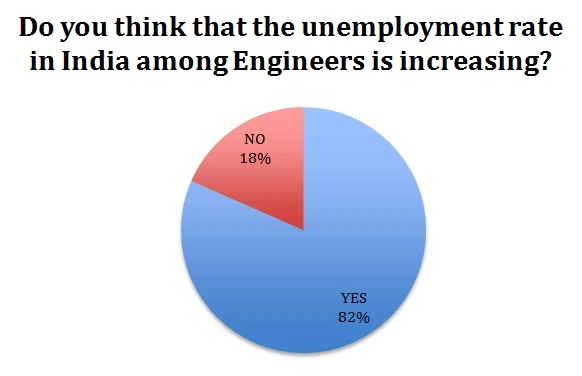
68% of the prospective graduate engineers think that engineersare not technically fit for their jobs while 32% of engineers aretechnically fit for their jobs according to their specialization.
| Q 2 | Yes | No |
|---|---|---|
| No. Of Respondents | 16 | 34 |
| Percentage | 32 | 68 |

About 3/4th of the total no.of respondents are positive that are academic qualification fulfill the basic requirement for getting a job. The reason for such result can be attributed to the fact that most of the companies nowadays have an inhouse training cell. So qualification wise the companies assume that they are fit to be working and hence they get placed for a job.
| Q 3 | Yes | No |
|---|---|---|
| No. Of Respondents | 13 | 37 |
| Percentage | 26 | 74 |
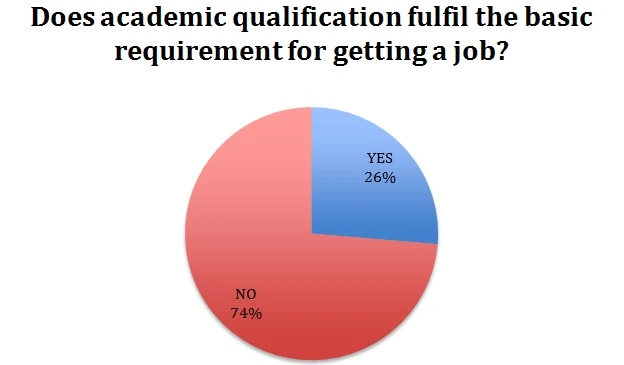
From the result obtained, it was found that 84% of graduate engineers think that soft skills, like communicative skill, etiquettes are equally important for employment and 16% of them feel that they are not important. This minority feels that employment is entirely on the basis of the merit of their marks. But we must give importance to the communication skills because in corporates and manufacturing firms interaction among seniors, peers and juniors play a crucial role.
| Q 4 | Yes | No |
|---|---|---|
| No. Of Respondents | 42 | 8 |
| Percentage | 84 | 16 |

From the observation we get to know that 68% of the graduate engineers did not agree to the point that diploma courses in engineering help in getting jobs more than the graduate engineers. While 32% of them agreed that at some point of time,diploma courses do help a person to get a job rather than, being laid back at home. Furthermore, some students do not have the financial assistance which can support the four year engineering course. So they opt for diploma courses which can provide them a job faster as compared to a graduate course in a cost effective manner.
| Q 6 | Yes | No |
|---|---|---|
| No. Of Respondents | 32 | 18 |
| Percentage | 63 | 37 |
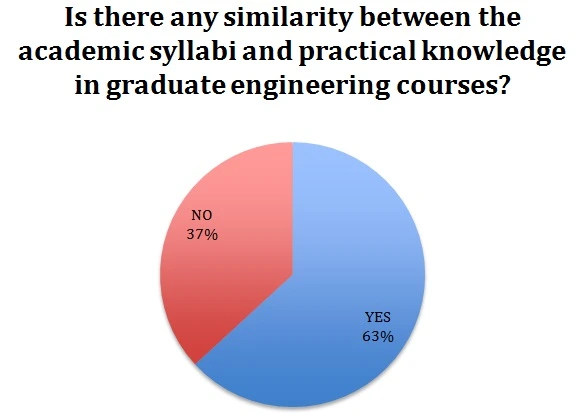
The result of the survey implies, that 79% of the graduate engineers do not agree that an increase in the number of engineering colleges imply an increase in employment rate. On the other hand it is noticed that 21% of them feel that an increase in the number of engineering institutions, do increase the employability rate. An increase in engineering colleges does not assure an increase in the employment rate. This is so because there are factors which combine to create a good engineering colleges. For example:- Having recruitment of good professors, should have necessary infrastructure, proper screening and counseling of students who would be admitted to those colleges, etc. So just an increase in number of colleges does not necessarily mean an increase in employment rate.
| Q 7 | Yes | No |
|---|---|---|
| No. Of Respondents | 11 | 39 |
| Percentage | 21 | 79 |
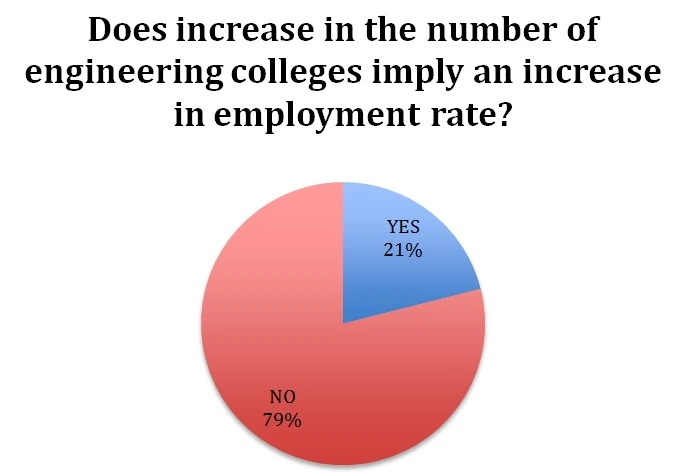
74% of the prospective graduate engineers agreethat college reputation is an important factor in determining the employability rate. Whereas, on the other hand, 26% of them think that college reputation is not dependent for employability rate. Well-reputed institutes are known across firms,industries and prospective students who aspire to study there.It has long years of establishment. Professors with years of experience also want to be a part of these institutes. These institutes are well funded by the government and encourage innovations and research work. Admissions for the students to the well-reputed colleges are very competitive.Companies prefer to employ more students from well-reputed colleges compared to a college, which is not known to many.
| Q 8 | Yes | No |
|---|---|---|
| No. Of Respondents | 37 | 13 |
| Percentage | 74 | 26 |
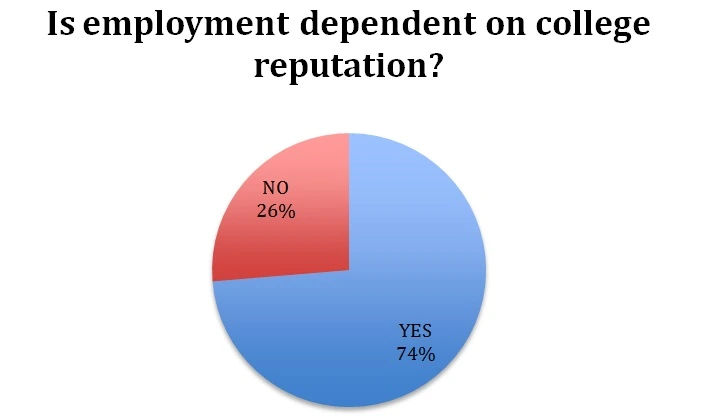
From the result obtained,it was found that 66% of the graduate engineers agree that higher studies in engineering increase the employability.While 34% of them think that it is not required to secure higher studies, in order to get employability. Higher studies imply specialized knowledge in a particular area of engineering which indicates a better chance for employment. The only downside of investing another couple of years in education means an equal reduction in hands-on experience at the job. There is a good percentage, though lesser, of the respondents who think that the on-the-job experience also adds a lot of value than pursuing higher studies. Thus, it can be said that higher studies to a certain extent play an important role in increasing employability.
| Q 9 | Yes | No |
|---|---|---|
| No. Of Respondents | 33 | 17 |
| Percentage | 66 | 34 |
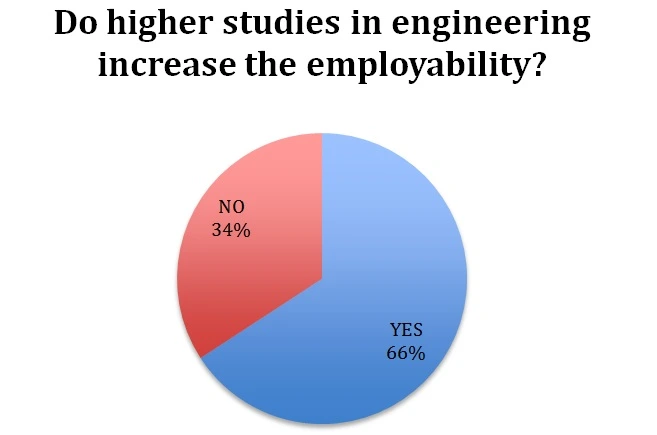
58% of the prospective graduate engineers think that the education system in our country contribute to an increase in unemployment, while 42% feel that education system does not contribute to an increase in unemployability rate. Here, it is imperative to note that by education system one means dispersal of knowledge at primary and secondary levels as well, and not only at the graduate level. The ever-increasing population puts a pressure on teaching capability at schools. The shortage in faculty for large class sizes affects the teacher-student ratio. As a result there is a fall in the quality of teaching. This in turn adversely effects the foundation of knowledge and thus contributes to unemployment.
| Q 10 | Yes | No |
|---|---|---|
| No. Of Respondents | 29 | 21 |
| Percentage | 58 | 42 |
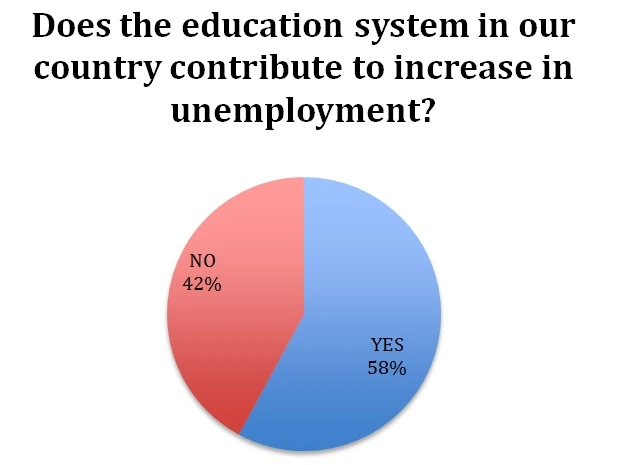
The survey revealed that 84% agreed that lower than average pay plays a vital role in unemployment among graduate engineers.While 16% disagreed to it. Salary plays an important factor for deciding to take up a job. During the placements students keep looking out for a job, which pay them at par with the present day averages. Additional factors include cost of living, nature of the job and responsibilities to be taken up. Many a times students keep waiting for the job with the right pay and thus lose out on opportunities, ending up as unemployed. Lower-than-average pay not necessarily indicates a “bad job” though. Often start-ups, which focus on innovative products, recruit engineering graduates. These small sized companies donot have huge pay, but provide ample opportunities for growth.
| Q 11 | Yes | No |
|---|---|---|
| No. Of Respondents | 42 | 8 |
| Percentage | 84 | 16 |
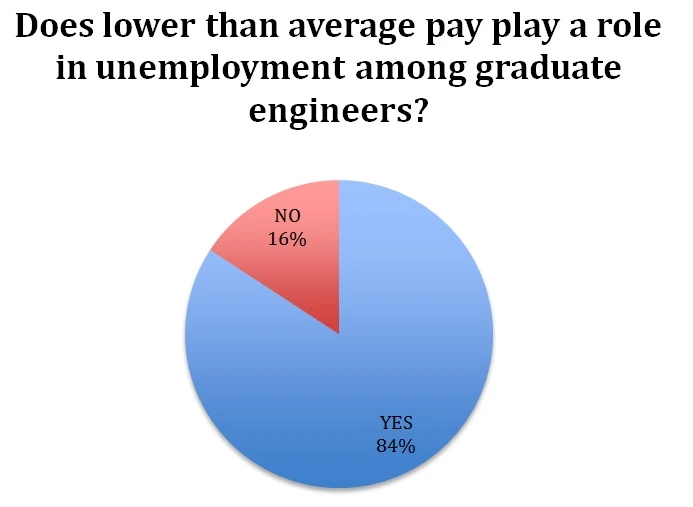
From the result obtained, it is found that 71% of the graduate engineers think that unemployment is more prevalent among the younger generation of graduate engineers.While 29% feel that its not only among younger generation but also prevalent among people between 45-55 years of age.India is a young countrywith more than 50% of its population below the age of 25 and more than 65% below the age of 35. Thereby making the younger generation prone to unemployment compared to the older generation. People between 45-55 years have experience and relevant knowledge, which help them to find a good stand for employment. But, it has been observed that unemployment among the older generation persists when there is an upgradation or dramatic change in technology. The Business Process Outsourcing industry, especially the ITes-BPO employs people who are young.
| Q 12 | Yes | No |
|---|---|---|
| No. Of Respondents | 36 | 14 |
| Percentage | 71 | 29 |
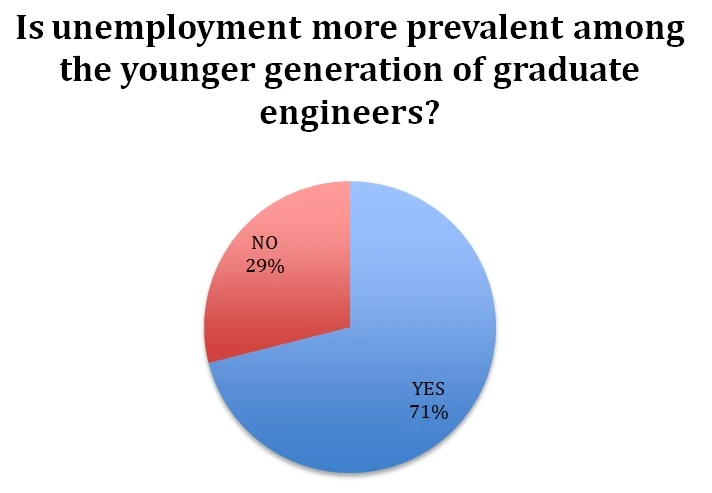
The survey revealed that 34% of the graduate engineers think that the machines created by present engineers are taking away the employment opportunities for the future ones.While 66% strongly rejects to the opinion that the machinesare taking away the employment opportunities for the future ones. People create machines,but machines do not create people. Machines aid in making work easier, whereas it is the engineers with skill and knowledge who know how to run the machine in an efficient manner. Therefore, it can be said that machines always do no take away the employment opportunities for the future ones. But with the advent of technological renovations it is necessary for engineers to keep themselves updated.
| Q 13 | Yes | No |
|---|---|---|
| No. Of Respondents | 17 | 33 |
| Percentage | 34 | 66 |

63% of the graduate engineers think that Government jobs create short term unemployment. And on the other hand ,37% think that the government jobs do not create short term unemployment. Engineers tend to sit back at home, hoping that they will be getting a Government job , which in turn keeps them unemployed for some period of time. Government jobs provide job security which is not there for private corporate firms.So some engineers keep looking for jobs which are under the government .The Government sectors conduct several competitive exams such as UPSC, IAS, WBCS etc.
| Q 14 | Yes | No |
|---|---|---|
| No. Of Respondents | 32 | 18 |
| Percentage | 63 | 37 |

71% of the graduate engineers strongly feel that unemployment can pave way for entrepreneurship. While 29% of them felt that it does not pave way for unemployment. The reputed institutes, like the IITs have a support cell, which provides opportunities to those who have not been able to bag an offer or have interests in unconventional and innovative areas. For eg, IIT Bombay has an Entrepreneurship Cell, known as the “e cell” which believes that entrepreneurship can unlock India’s latent inventive potential. Moreover, in times of technological advancement and easy availability of loans from banks provide support to an idea, which has the necessary ingredients for success. Interests in other vocations like, photography, mountaineering, writing, etc can also provide path to an unconventional career.
| Q 15 | Yes | No |
|---|---|---|
| No. Of Respondents | 36 | 11 |
| Percentage | 71 | 29 |
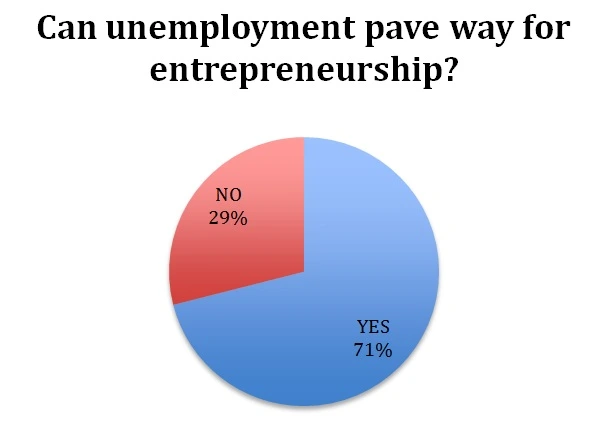
Conclusion:-
From the survey, it has been concluded that the unemployment in India is increasing at an alarming rate and this had to be reduced at a considerable rate. Graduates unable to translate theory into practice. Graduates fail to communicate effectively with employersduting their selection process. Graduates stress the need to begin career planning earlier. A few suggestions and limitations are elaborated below :-
Suggestions :-
- Government should look upon the matter of unemployability of graduate engineers in India, by introducing policy planning and emphasisong on it. Thus reducing the unemployablity to a considerable rate.
- A country like India ,should develop and upgrade the level of education system.
- College must provide basic infrastructure ,equipments to the engineering students.
- The graduate engineers must be paid properly,in accordance of their ability and qualification.
- Unemployablity among the younger generation is more prevalent, and hence this leads to youth problems,such as, addiction,alienation, identity crisis. This must be solved by supplying them with a minimum wage employability.
- Diploma courses should be also be encouraged .
This essay has been submitted to us by a student in order to help you with your studies. This is not an example of the work written by our professional essay writers.
Limitations :-
- Since, this project was time-bound, that is the reason why it was not possible to conduct a survey on any sort of gender-bias or inequality, faced by the engineers at their workplace. Otherwise, if time had permitted, then it would have been possible to conduct this particular survey.
- In this project, the number of engineering colleges were limited. There are several engineering colleges all over India. But, hereby the number of colleges surveyed are five.
- The sample size of 50 is not a true representation of population since there was time restriction.
Questionnaire On Unemployment Of Graduate Engineers In India
Name :-
Age :-
Gender :-
Name Of The Institute :-
- Do you think that the unemployment rate in India among engineers is increasing?
- Do you think engineers nowadays are technically fit for their jobs according to their specialization?
- Does academic qualification fulfill the basic requirement for getting a job?
- As population is increasing in our country, is this a problem and a reason for unemployment?
- Are soft skills, like, communicative skill, etiquettes, equally important for employment?
- Do diploma courses in engineering help in getting jobs more than graduate engineers?
- Have companies lost confidence in engineers?
- Is there any similarity between the academic syllabi and practical knowledge in graduate engineering courses?
- Does increase in the number of engineering colleges imply an increase in employment rate?
10.Is employment dependent on college reputation?
11.Do higher studies in engineering increase the employability?
12.Does the education system in our country contribute to increase in unemployment?
13.Does the college provide ample opportunities that simulate real-life problems and encourage students to work on them?
14.Does lower-than-average pay; play a role in unemployment among graduate engineers?
15.Is unemployment more prevalent among the younger generation of graduate engineers?
16.Can unemployment pave way for entrepreneurship, like, starting a new business?
17.Does preference for Government jobs create short-term unemployment?
18.“ Institutes do not teach what industries require. Industries do not require what institutes teach”. Do you agree?
19.Should Government intervene in the problem of unemployment of graduate engineers?
20.Does continuous policy emphasis and planning programs address to the problem of unemployment?
21. Do you think that the engineering education system/syllabus in India is much more theory based ?
22.Does shortage in producing quality graduate engineers increase the rate of unemployment?
23.Whether machines created by present day engineers, taking away the employment opportunities for the future ones?
24. “Contractual jobs,leads to bonded labours” . Do you think that would limit the labourers from their employability?
25 .Does incompetent faculty,such as lacking basic infrastructure and equipments , rendering engineering graduates unemployable?






